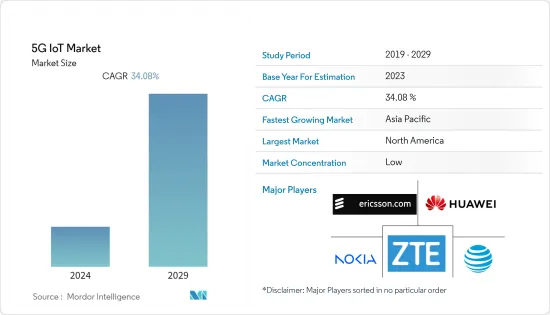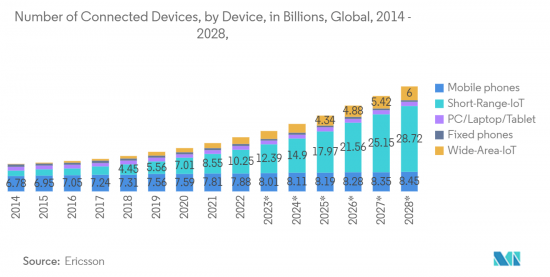PUBLISHER: Mordor Intelligence | PRODUCT CODE: 1406577

PUBLISHER: Mordor Intelligence | PRODUCT CODE: 1406577
5G IoT - Market Share Analysis, Industry Trends & Statistics, Growth Forecasts 2024 - 2029

The 5G IoT Market was valued at USD 9.54 billion in the current year. The market is expected to reach USD 55.86 billion in five years, registering a CAGR of 34.08% during the forecast period. 5G is essential to the Internet of Things because of the need for a faster network with higher capacity that can serve connectivity needs. The 5G spectrum increases the frequencies on which cellular technologies will transfer data. This broader spectrum for use increases the overall bandwidth of mobile networks, allowing additional devices to connect.
Key Highlights
- 5G IoT networks are designed to support many connected devices simultaneously. This capability is critical in IoT applications, where many sensors, cameras, and other devices need to communicate and exchange data efficiently. According to Cisco Systems, the number of connected wearable devices in North America is expected to reach 439 million by 2022 from 378.8 million in 2021. Moreover, Ericsson says the number of smartphone mobile network subscriptions globally reached almost 6.6 billion in 2022 and is forecast to exceed 7.8 billion by 2028. this is expected to drive the market further.
- As the Internet of Things expands and more devices become interconnected, there is a growing need for reliable and robust communication infrastructure to support this massive scale of connectivity. As a result, the 5G IoT market is expected to experience substantial growth, with an increasing number of industries and sectors leveraging the potential of 5G to realize their IoT ambitions.
- The advantage of 5G over LTE for low latency and critical applications makes it a compelling choice for industries and sectors that require real-time data processing and reliable connectivity. As the demand for low latency and critical IoT applications increases, the adoption of 5G for such use cases will drive the growth of the 5G IoT market, transforming various industries and enabling new innovative services and solutions.
- The cost of upgrading infrastructure from LTE to 5G restrains the market growth. While 5G offers numerous advantages for IoT applications, including low latency, increased capacity, and higher data speeds, the expenses associated with deploying 5G networks and upgrading existing infrastructure can pose challenges, especially for certain industries and regions.
- The COVID-19 pandemic underscored the importance of smart city solutions for public safety and urban management. 5G IoT applications like contact tracing, crowd monitoring, and smart infrastructure gained attention. Many businesses accelerated digital transformation initiatives during the pandemic to adapt to the new normal. This includes adopting IoT solutions enabled by 5G for improved efficiency, productivity, and automation.
5G Internet of Things (IoT) Market Trends
Automotive Industry is Expected to Witness Significant Growth Rate
- The Automotive industry was one of the most significant segments in the 5G IoT market. 5G's ultra-fast and low-latency capabilities allow for seamless connectivity between vehicles and the cloud, enabling real-time data exchange. Connected cars can gather information on traffic conditions, weather, and road hazards, enhancing safety, better navigation, and improved driver assistance systems.
- 5G IoT enables V2X communication, which allows vehicles to communicate with other vehicles (V2V), infrastructure (V2I), pedestrians (V2P), and network (V2N). This connectivity improves road safety and traffic management, creating a foundation for autonomous driving.
- 5G IoT can improve supply chain management by enabling real-time tracking and monitoring of vehicle components and parts, leading to better inventory management and reduced downtime.
- The successful deployment of autonomous vehicles heavily relies on a robust and reliable network infrastructure. 5G's low latency and high data transfer rates are crucial for real-time communication between autonomous vehicles and other connected devices, making it a key enabler for self-driving cars.
- According to Ericsson, the number of connected devices globally is set to approximately double within five years. This growth is expected to be driven by an increase in short-range IoT (Internet of Things) devices, with 28.72 billion such devices forecast in five years. Connected devices include wearables, connected cars, and smart sensors.

North America is Expected to Hold Significant Market Share
- North America was among the first regions to deploy 5G networks commercially, with significant telecommunication companies investing heavily in 5G infrastructure. The early rollout of 5G has enabled the region to develop a robust ecosystem for various IoT applications. The booming
- 5G deployments in the country will increase the demand for 5g infrastructure to support the 5G features and services being rolled out. For instance, according to Ericsson, there will be more than 195 million 5G subscriptions in three years, and in six years, in the United States, 5G will account for about 71.5% of the entire U.S. mobile market.
- The region has seen significant adoption of Industrial IoT (IIoT) solutions in various sectors, including manufacturing, energy, and utilities. 5G's high-speed, low-latency connectivity enhances the capabilities of IIoT, enabling real-time data analytics and remote monitoring. According to CTIA, rapid growth creates a platform for the United States' 5G economy. It will lead to USD 275 billion in investment and 3 million new jobs, creating USD 500 billion in economic growth.
- Several cities in North America have embarked on smart city initiatives, using 5G IoT technologies to improve urban infrastructure, transportation, public safety, and citizen services.
- North America is a hub for the automotive industry and has witnessed rapid growth in connected vehicle solutions. 5G IoT enables advanced V2X (Vehicle-to-Everything) communication, facilitating safer and more efficient transportation.
5G Internet of Things (IoT) Industry Overview
The 5G IoT Market is highly fragmented, with major players like Nokia Corporation, AT&T Inc., Huawei Technologies Co Ltd, Telefonaktiebolaget LM Ericsson, and ZTE Corporation. Players in the market are adopting strategies such as partnerships and acquisitions to enhance their product offerings and gain sustainable competitive advantage.
In June 2023, Ericsson and Ooredoo Qatar signed a five-year extension of their 5G deal during Ooredoo Qatar's visit to Ericsson's headquarters in Kista, Sweden, to increase collaboration on radio access network (RAN) products and services. Ericsson will deliver advanced 5G RAN solutions and services that enable faster data speeds, allowing Ooredoo Qatar to explore new 5G use cases and connectivity opportunities for subscribers, leverage the potential of Internet of Things (IoT) applications, and explore emerging technologies like artificial intelligence (AI), and machine learning (ML) for optimizing network performance and user experience.
In February 2023, Cisco and NEC Corporation announced plans to expand their collaboration efforts to include system integration solutions and potential opportunities in 5G xHaul and private 5G to help consumer transform their architecture and connect more people and things.
Additional Benefits:
- The market estimate (ME) sheet in Excel format
- 3 months of analyst support
TABLE OF CONTENTS
1 INTRODUCTION
- 1.1 Study Assumptions and Market Defnition
- 1.2 Scope of the Study
2 RESEARCH METHODOLOGY
3 EXECUTIVE SUMMARY
4 MARKET INSIGHTS
- 4.1 Market Overview
- 4.2 Industry Attractiveness - Porter's Five Forces Analysis
- 4.2.1 Bargaining Power of Suppliers
- 4.2.2 Bargaining Power of Buyers/Consumers
- 4.2.3 Threat of New Entrants
- 4.2.4 Threat of Substitute Products
- 4.2.5 Intensity of Competitive Rivalry
- 4.3 Technology Snapshot
5 MARKET DYNAMICS
- 5.1 Market Drivers
- 5.1.1 The Ability of 5G Technology to Handle Millions of IoT Connected Devices
- 5.1.2 Advantages of 5G over LTE for Low Latency and Critical Applications
- 5.2 Market Restraints
- 5.2.1 Existing 4G LTE Technology is Sufficient for Certain IoT Use Cases
- 5.2.2 Costs Involved in the up-gradation of the Infrastructure from LTE to 5G
6 MARKET SEGMENTATION
- 6.1 By Technology
- 6.1.1 Ultra-Reliable Low-Latency Communications (URLLC)
- 6.1.2 Low-Power Wide-Area Network (LPWAN)
- 6.2 By End-User Industry
- 6.2.1 Manufacturing
- 6.2.2 Supply Chain
- 6.2.3 Healthcare
- 6.2.4 Retail
- 6.2.5 Smart Cities
- 6.2.6 Automotive
- 6.3 By Geography
- 6.3.1 North America
- 6.3.1.1 United States
- 6.3.1.2 Canada
- 6.3.1.3 Mexico
- 6.3.1.4 Rest of North America
- 6.3.2 Europe
- 6.3.2.1 Germany
- 6.3.2.2 United Kingdom
- 6.3.2.3 France
- 6.3.2.4 Russia
- 6.3.2.5 Spain
- 6.3.2.6 Rest of Europe
- 6.3.3 Asia Pacific
- 6.3.3.1 India
- 6.3.3.2 China
- 6.3.3.3 Japan
- 6.3.3.4 Rest of Asia Pacific
- 6.3.4 South America
- 6.3.4.1 Brazil
- 6.3.4.2 Argentina
- 6.3.4.3 Rest of South America
- 6.3.5 Middle East and Africa
- 6.3.5.1 UAE
- 6.3.5.2 Saudi Arabia
- 6.3.5.3 Africa
- 6.3.1 North America
7 COMPETITIVE LANDSCAPE
- 7.1 Company Profiles
- 7.1.1 Nokia Corporation
- 7.1.2 AT&T Inc.
- 7.1.3 Huawei Technologies Co Ltd
- 7.1.4 Telefonaktiebolaget LM Ericsson
- 7.1.5 ZTE Corporation
- 7.1.6 Cisco Systems Inc
- 7.1.7 Deutsche Telekom AG (T-Mobile)
- 7.1.8 Verizon Communication Inc
- 7.1.9 Sprint Corp
- 7.1.10 Vodafone Group PLC
8 MARKET OPPORTUNITIES AND FUTURE TRENDS




